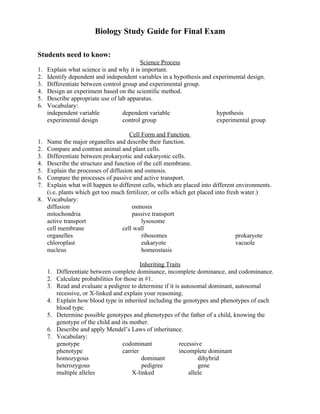
Biology Study Guide for Final Exam Topics
- 1. Biology Study Guide for Final Exam Students need to know: Science Process 1. Explain what science is and why it is important. 2. Identify dependent and independent variables in a hypothesis and experimental design. 3. Differentiate between control group and experimental group. 4. Design an experiment based on the scientific method. 5. Describe appropriate use of lab apparatus. 6. Vocabulary: independent variable dependent variable hypothesis experimental design control group experimental group Cell Form and Function 1. Name the major organelles and describe their function. 2. Compare and contrast animal and plant cells. 3. Differentiate between prokaryotic and eukaryotic cells. 4. Describe the structure and function of the cell membrane. 5. Explain the processes of diffusion and osmosis. 6. Compare the processes of passive and active transport. 7. Explain what will happen to different cells, which are placed into different environments. (i.e. plants which get too much fertilizer, or cells which get placed into fresh water.) 8. Vocabulary: diffusion osmosis mitochondria passive transport active transport lysosome cell membrane cell wall organelles ribosomes prokaryote chloroplast eukaryote vacuole nucleus homeostasis Inheriting Traits 1. Differentiate between complete dominance, incomplete dominance, and codominance. 2. Calculate probabilities for those in #1. 3. Read and evaluate a pedigree to determine if it is autosomal dominant, autosomal recessive, or X-linked and explain your reasoning. 4. Explain how blood type in inherited including the genotypes and phenotypes of each blood type. 5. Determine possible genotypes and phenotypes of the father of a child, knowing the genotype of the child and its mother. 6. Describe and apply Mendel’s Laws of inheritance. 7. Vocabulary: genotype codominant recessive phenotype carrier incomplete dominant homozygous dominant dihybrid heterozygous pedigree gene multiple alleles X-linked allele
- 2. Energy Transfer 1. Show the energy flow through a food chain and food web. 2. Distinguish between autotrophs and heterotrophs and identify them given examples. 3. Explain the importance of an energy pyramid and how energy changes from one trophic level to another. 4. List the products and reactants of both photosynthesis and cellular respiration. 5. Describe how the products and reactants of photosynthesis and cellular respiration are cycled through an ecosystem. 6. Vocabulary: food chain omnivore food web herbivore autotroph carnivore heterotroph photosynthesis producer cellular respiration consumer decomposer trophic level Populations/Communities/Ecosystems 1. Recognize and describe biotic and abiotic factors in the biosphere. 2. Describe and recognize examples of symbiotic relationships (mutualism, commensalisms, and parasitism) and competition. 3. Predict how predator-prey relationships, limiting factors, carrying capacity, and environmental changes affect population size. 4. Differentiate between density dependent and density independent factors. 5. Identify biotic and abiotic factors that may affect the carrying capacity of a population.. 6. Explain how human activities affect ecosystems. 7. Vocabulary: population parasitism biotic commensalisms abiotic competition carrying capacity logistic ecosystem exponential predator/prey dependent factors independent factors mutualism habitat community Evolution 1. Define natural selection and describe how it works using examples. 2. Differentiate between homologous structures and vestigial structures and explain why they are important to scientists studying evolution. 3. Explain how embryology, molecular biology, fossil evidence, and anatomy are used as evidence of common descent. 4. Explain what genetic variation means and how it occurs. 5. Define adaptation in terms of evolution. 6. Using an example, differentiate between the theories of evolution of Charles Darwin and Jean Lamarck. 7. Define fitness in terms of evolution. 8. Vocabulary: natural selection adaptation speciation homologous structures fitness vestigial structures dating
- 3. DNA Structure and Function 1. Explain the two principal functions of DNA. 2. Describe the structure of DNA. 3. List the bases and how they pair. 4. Summarize the process of replication. 5. Describe the processes of transcription and translation. 6. Differentiate between point and chromosomal mutations. 7. Know the following vocabulary words: Adenine Uracil Cytosine Ribose Deoxyribose Thymine phosphate point mutation gene nucleotide Guanine transcription translation replication Cell Division 1. Describe the events of the cell cycle. 2. Describe the events of mitosis and be able to order pictures of cells in various phases of mitosis. 3. Identify structures in cells during mitosis 4. Explain the purpose of mitosis and meiosis 5. Explain why meiosis is important in a sexual reproductive cycle. 6. Explain how meiosis maintains genetic diversity in a species. 7. Compare and contrast the processes of meiosis and mitosis. 8. Describe the process of nondisjunction and its affect on gametes as well as offspring. 9. Vocabulary: mitosis meiosis interphase prophase metaphase centrioles anaphase centromere telophase spindle fibers cytokinesis nondisjunction gametes Organic Molecules 1. Identify general structure of lipids, carbohydrates, proteins and nucleic acids. 2. Identify three unique properties of water. 3. Identify the six most common elements in organic compounds. 4. Identify which organic compound contains the most energy per gram and why. 5. Understand the primary function of the four main organic compounds. 6. Vocabulary: polarity lipids cohesion carbohydrates adhesion nucleic acids capillary action proteins surface tension hydrogen bonds covalent bonds
